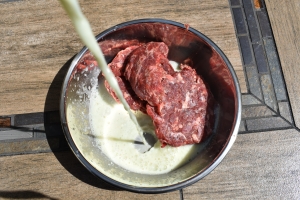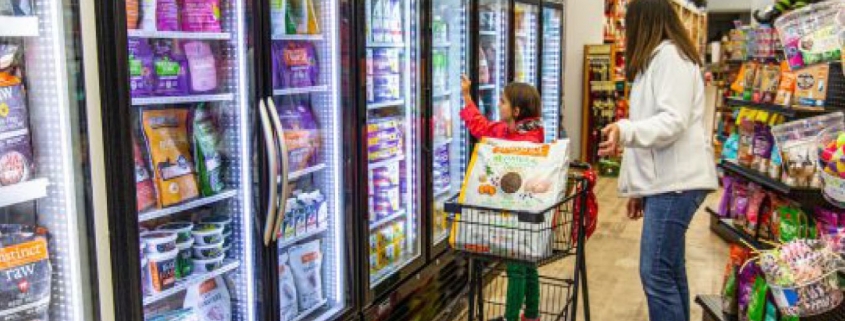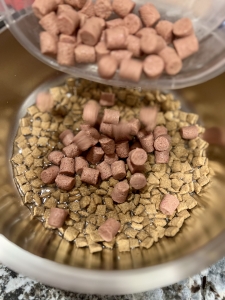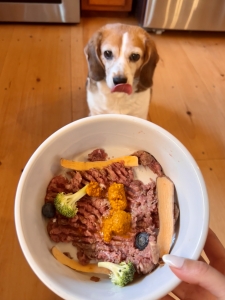AVMA, Nutrition & (lack of) Ethics
How many times have you heard a veterinarian or the American Veterinary Medical Association (AVMA) preach that those who are not veterinarians should not be giving nutritional advice? Probably more than a few times. Interesting, maybe the AVMA should take their own advice before distributing an unvalidated, unscientific internet blog. Or, maybe they should rise to meet their own ethics pillars when disseminating information which is unable to withstand basic scientific scrutiny. In short, this is a scientific body distributing subpar work that would get a student ejected from any reputable undergraduate or graduate program.

Unpopular fact is that most, but not all, veterinarians have a knowledge gap when it comes to nutrition, aside from the fact that the little nutrition training they receive is influenced by large food manufactuerers1,2. It is probably time veterinarians started engaging with those that went to school to study things like nutrition and biochemistry since nutrition has everything to do with pathology of disease and disease prevention. If this body continues to ignore their knowledge gap they are going to continue distributing information that is inaccurate and dangerous – which can arguably be considered negligent. Considering these issues, they should probably review their “Core Values” and realign some of their messaging. Is this bold? Sure, but it’s also the truth.
The AVMA, according to the about section of their website:
…is a professional, not-for-profit organization claiming to be the collective voice of the veterinary profession. It is comprised of over 95,000 members from government, private practice, industry, uniformed services and academia that protect, promote and advance the needs of all veterinarians and those they serve. Their core values state that the AVMA is ethical, inclusive, science-based, animal-focused, member-centric, supportive, fiscally responsible, efficient & innovative3.
Interesting considering the AVMA has routinely made it clear that their opinion and recommendations are for purchase by major corporations such as Hill’s, Royal Canin and major pharmaceutical companies through various email and marketing campaigns – just for example (see figures 1-4)3. It is also clear that they do not regularly verify and critically review the “scientific” information they distribute to their members who take it as scientific fact4. The AVMA also continues to warn against pathogens in raw food (figure 5), most recently by citing 3 abstracts that were not peer-reviewed, and who’s conclusions either didn’t match what the AVMA claimed, or had conclusions of which data did not support5. These abstracts and their argument also are unable to withstand basic scientific scrutiny. You can read my full analysis of that incident here. Based on this alone we can toss ‘ethical’ and ‘science-based’ from their “Core Values”. Arguably there are a few more, but I’ll be nice.


Another example, on May 22nd the AVMA distributed a blog by “PopSugar” which was just another example of them not vetting their sources (see figure 6). This was a non-scientific article that was incomplete, inaccurate and full of dangerous nutritional information. While the blogger interviewed a veterinarian, that veterinarian made her nutritional knowledge gaps apparent. The worst part being that the AVMA shared it, in a member email, which indicates their need to expand engagement to nutrition academics and learn to admit what they do not know.
Here are just two highlights from that article:
Consult a Board-Certified Veterinary Nutritionist:
The article stresses the importance of consulting a veterinarian or veterinary nutritionist before making food changes for your pet. We’ve already covered the fact that many veterinarians have nutritional knowledge gaps. A board-certified veterinary nutritionist® is a Diplomate of the American College of Veterinary Nutrition (ACVN®). The ACVN® is the AVMA-recognized specialty organization for nutrition. They are veterinarians who have continued training specifically in the field of nutrition to become board-certified specialists in veterinary nutrition. This can include companion, livestock and exotic species.
This is a great recommendation, if you can find and afford one. Most articles that advise contacting a veterinary nutritionist fail to acknowledge that there are not enough of them to go around. According to the ACVN website there are only 96 veterinarians that are currently board-certified in animal nutrition. The list narrows further because many do not take appointments with individual clients because they are working in other capacities (such as academia or formulation), not taking new clients, only see clients in person or are retired. The AVMA and ACVN know this, so one could argue that it is an unreasonable recommendation because there simply are not enough to meet demand.
This leaves nutrition advice falling onto the shoulders of veterinarians, many of which are unequipped to fully handle this field. Don’t get me wrong, there are some that are extremely capable in the field of nutrition, some of which whom I’ve been fortunate enough to learn from. The fact remains that the majority are not, and most don’t have the luxury of working with a board-certified nutritionist.
Not to mention the fact that opinions and practice among these board-certified veterinary nutritionists vary widely. Some advocate for the feeding of fresh food, some do not. Some advocate for prescription diets, some do not. The AVMA ignores this wide range of opinions and seems to focus in on those who only promote what their sponsors do. They also ignore that there are other qualified members of the scientific and nutrition communities that are qualified to make nutritional recommendations and evolve the field. So, I guess we can also cross off inclusive, supportive, scientific and efficient from the AVMA core values.
A 1:1:1 Approximate Ratio Can Help Build A Balanced Food Plan for Your Dog:
Sounds good, right? Wrong. In fact, this is an incorrect and irresponsible recommendation on many levels that it is hard to pick a place to start:
- It doesn’t fully explain what those ratios mean. Does that ratio recommendation mean a ratio of calories or by weight? These could yield two very different things to the unsuspecting consumer.
- There is no account for age/life stage, breed or size of the dog – nor does it account for activity levels which can dramatically shift energy requirements and therefore macronutrient needs. For example, what about large breeds and puppies who have specific protein and energy requirements?
- Interesting how the recommendation is to refer to balanceit.com – which doesn’t even recommend those macronutrient ratios.
- The recommendation completely ignores amino acid and fatty acid requirements and seems to imply that providing equal parts protein, fat and carbohydrates would supply all required micronutrients. This is simply not the case at all.
Ultimately calories from protein, fat and carbohydrates should vary based on the age, size, breed, activity level and other variables that determine daily energy requirement (DER). While it is difficult to make a blanket recommendation, here are some general points to consider:
- According to the National Research Council (NRC) a growing puppy requires a diet that is about 29 percent protein by weight. This protein should provide about 20-25 percent of dietary calories for puppies. The NRC also states that adults need about 18 percent dietary protein6. It’s important to note that many dog foods on the market range from 18-35% of calories from protein and that more research is needed to determine what is actually optimal.
- Typically, a range of 5-20% of calories in commercial dog food come from fat. Although 25-50% of the daily energy requirement can be supplied by fat during periods of high caloric need such as growth, lactation, or physical exertion. Remember that fat is nearly twice as nutrient dense as protein and carbohydrates, meaning that it is easy to provide excess calories which may contribute to obesity. This recommendation can also be altered based on disease state or other metabolic factors. Too much fat can also inhibit other nutrients from being provided or metabolized properly, which is yet another factor to consider.
- The topic of carbohydrates is a highly contested one. There is not an absolute requirement for carbohydrates in dogs – some sources state that without dietary carbohydrates, there is added strain on lipid and protein metabolic pathways to supply glucose precursors6,7. However, newer scientific literature suggests that some working dogs may do better with minimal dietary carbohydrate8. I make this point not in favor of one stance or the other – instead that the field of nutrition is constantly evolving and to highlight the need for engagement all professionals within the field.
- Remember the primary purpose of carbohydrates in pet food is to supply energy. However, also remember that carbohydrates include both soluble and insoluble fiber; of which both can provide benefit. Fruits and vegetables provide both types of fiber also provide antioxidants. Antioxidants can prevent oxidation (rancidity) of fats, which is important – especially in higher fat diets. Further complicating matters, excess carbohydrates can inhibit various metabolic pathways leading to nutrient deficiency and/or imbalance and even metabolic disease like obesity and diabetes.
The Main Point:
Obviously, this is just barely scratching the surface, since this is such a complex topic. The main point is that this article leaves a lot of room for misinterpretation and error – aside from the fact that this recommendation is not science-based at all. This is obviously a complex topic and is deserving of those who are qualified to discuss it. Because of this, we can add additional ticks against the AVMA core values of being ethical, science-based, animal-focused, supportive, efficient and innovative.
I could go on further about some of the egregious inaccuracies and recommendations in the article, but it would be a moot point. Instead I would rather spend the remainder of my energy and your valuable time expanding upon something that is worth understanding: the science of nutrition.
The Elephant in the Room: What is the Science of Nutrition?
The field of nutrition is a complex one, and it is not explored in depth in human or animal medical school. This topic is really deserving of its own article, because many really don’t fully understand just how complex it is. In fact, the nutrition field has its own set of education and degree structures that as intense, and in some cases more intense than medical programs. Depending on the track, nutrition encompasses working knowledge of many disciplines. These include, but are not limited to biology, microbiology, chemistry, biochemistry, physics, immunology, endocrinology, pathology, and more. Years ago, the nutrition field was looked down upon by many within the scientific community. Only now is that community realizing just how fundamentally important nutrition is to health, medicine and longevity.
But This Is How It Has Always Been Done
We’re in the midst of a paradigm shift, and it is getting ugly. It’s hard for educated professionals to admit what they don’t know. It’s even harder when they get called out for disseminating bad information. However, until they start to engage those who are deserving of a seat at the table, they leave some us no other choice. On the human side we know that highly processed food, and excess soluble carbohydrates are causative factors in various diseases and comorbidities. In animals, we ignore this fact and continue to recommend highly processed foods. We also fail to recognize the role of nutrition in disease prevention and management. The dogma that veterinary medicine should remain the coveted source of recommendations for animal nutrition is one that is losing stature each day.
Instead of refusing to engage in conversation and advance the field, the veterinary community would be better served by embracing ideas and research from those outside their immediate circle. Only then would the AVMA and the community they claim to represent begin to actually work toward what their ethics pillars state.
Nicole Cammack
Nicci is the owner of award-winning NorthPoint Pets & Company, in Connecticut. She is also the Founder & CEO of Undogmatic Inc. Her undergraduate and graduate education includes biology, chemistry, business, and nutrition. She has worked in the pharmaceutical industry on multiple R&D projects and has had the privilege to learn from leading international figures in the human and pet health industry. She regularly lectures at national conferences, including federal, state, and municipal K9 events. Her current research involves identifying pathogenic risk factors and transmission among raw fed pets through a comprehensive worldwide survey.
www.northpointpets.com
www.undogmaticinc.com
References:
1. Albala K. The SAGE Encyclopedia of Food Issues. SAGE Publications; 2015.
2. Nestle M, Nesheim MC. Feed Your Pet Right: The Authoritative Guide to Feeding Your Dog and Cat. Free Press; 2010. Accessed May 25, 2020. https://nyuscholars.nyu.edu/en/publications/feed-your-pet-right-the-authoritative-guide-to-feeding-your-dog-a
3. We are AVMA. American Veterinary Medical Association. Accessed May 22, 2020. https://www.avma.org/about
4. Just because it looks like science doesn’t mean it is. NorthPoint Pets & Company. Published April 23, 2020. Accessed May 22, 2020. https://northpointpets.com/just-because-it-looks-like-science-doesnt-mean-it-is/
5. Apr 20 CD| NR| CN|, 2020. ECCMID studies probe resistant pathogens in pets, pet food, and people. CIDRAP. Accessed May 22, 2020. https://www.cidrap.umn.edu/news-perspective/2020/04/eccmid-studies-probe-resistant-pathogens-pets-pet-food-and-people
6. Read “Nutrient Requirements of Dogs and Cats” at NAP.Edu. doi:10.17226/10668
7. Hand et. al. Small Animal Clinical Nutrition. 5th ed. Mark Morris Institute
8. The effects of the proportions of dietary macronutrients on the digestibility, post-prandial endocrine responses and large intestinal fermentation of carbohydrate in working dogs: New Zealand Veterinary Journal: Vol 57, No 6. Accessed May 24, 2020. https://www.tandfonline.com/doi/abs/10.1080/00480169.2009.64718













